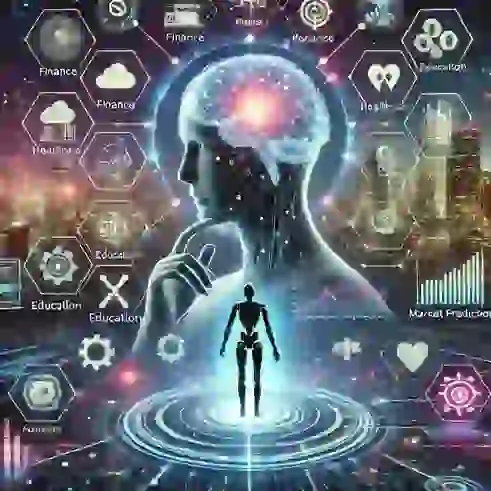Introduction
In 2025, generative artificial intelligence (AI) is emerging as the driving force behind digital transformation. With tech giants and startups integrating advanced AI models into their operations, generative AI is reshaping industries, streamlining workflows, and unlocking unprecedented creative potential. This article explores how generative AI is revolutionizing the tech landscape, its real-world applications, key trends, challenges, and future prospects.

What Is Generative AI?
Generative AI refers to AI systems capable of creating new content—ranging from text and images to music and video—using machine learning models. Unlike traditional AI, which relies on predefined responses, generative AI learns patterns from vast datasets and produces innovative outputs that mimic human creativity. Popular examples include:
- ChatGPT for text generation
- DALL-E for image creation
- Multimodal AI for combining text, audio, and visual data
These technologies are advancing rapidly, setting the stage for a new era of digital innovation.
How Generative AI Is Transforming the Tech Industry
1. Accelerating Digital Transformation
Generative AI is leading the charge in digital transformation by automating tasks, reducing costs, and enhancing productivity. Businesses leverage AI-powered tools for:
- Customer Support: AI-driven chatbots handle inquiries efficiently.
- Content Creation: Marketing teams use AI to generate personalized campaigns.
- Software Development: AI assists in coding, debugging, and optimizing applications.
2. Redefining Creativity and Content Production
Generative AI is revolutionizing creative industries. Designers, artists, and writers use AI to explore new styles and produce high-quality content at scale. This democratization of creativity enables small businesses to generate professional-quality content without large budgets.
3. Transforming Product Development
AI accelerates product design and innovation by predicting trends, optimizing designs, and creating prototypes. Industries such as automotive and consumer electronics leverage AI to simulate performance, test variations, and reduce time-to-market.
Key Trends in Generative AI for 2025
1. Integration into Enterprise Solutions
Generative AI is being embedded in enterprise software, such as CRM and ERP systems, to analyze data, forecast trends, and offer actionable insights. This enhances decision-making and improves customer experiences.
2. Cost Reduction and Efficiency Gains
As AI technology becomes more affordable, businesses of all sizes can integrate AI-driven solutions to automate processes, provide real-time analytics, and improve operational efficiency.
3. Expanding Applications Across Industries
Beyond tech, generative AI is making strides in:
- Finance: Predictive models for market trends and automated financial analysis.
- Healthcare: AI-driven diagnostic imaging, personalized treatment plans, and drug discovery.
- Education: AI-generated learning materials and personalized tutoring systems.
Challenges and Considerations
While generative AI offers immense potential, it also presents challenges:
- Ethical and Regulatory Concerns: Issues like bias, transparency, and accountability require strong ethical guidelines.
- Workforce Reskilling: Businesses must invest in training employees to work alongside AI.
- Data Privacy and Security: Protecting sensitive data from breaches is critical.
- Quality and Reliability: Continuous monitoring is needed to ensure AI-generated content is accurate and relevant.
The Future Outlook: What to Expect in 2025 and Beyond
Looking ahead, generative AI’s influence will continue to expand:
- Widespread Adoption: More industries will integrate AI into their core operations.
- Increased AI Research Investment: Public and private funding will drive breakthroughs.
- Enhanced Human-AI Collaboration: AI will act as a co-pilot, augmenting human intelligence and decision-making.
- Competitive Advantage: Companies that embrace AI will gain a market leadership edge.
Conclusion
Generative AI is more than just a tech trend—it is a transformative force reshaping businesses, creativity, and innovation. As companies navigate 2025, integrating generative AI into enterprise solutions, product development, and creative workflows will be crucial for staying ahead. By addressing challenges and leveraging AI’s full potential, organizations can lead the next digital revolution, paving the way for a smarter, more efficient future tech trends 2025.
Frequently Asked Questions (FAQ) About Artificial Intelligence
1. What is an AI?
Artificial Intelligence (AI) refers to computer systems designed to mimic human cognitive functions—such as learning, reasoning, problem-solving, and language understanding—to perform tasks that typically require human intelligence. AI systems can analyze data, recognize patterns, and adapt their responses based on experience.
2. What AI is used today?
Today’s AI is integrated into a wide range of applications. For example, virtual assistants like Siri and Alexa use natural language processing to understand and respond to queries; recommendation engines on platforms such as Netflix and Amazon personalize content based on user behavior; chatbots like ChatGPT offer conversational support; and autonomous vehicles and healthcare diagnostics rely on AI-powered data analysis to make real-time decisions.
3. What are the 4 types of AI?
AI can be categorized based on its functionalities into four main types:
- Reactive Machines: These systems respond to current inputs without using past experiences (e.g., IBM’s Deep Blue chess computer).
- Limited Memory: AI systems that use historical data to inform decisions, such as self-driving cars and many chatbots.
- Theory of Mind: A theoretical form of AI that would understand human emotions and thoughts, enabling more natural interactions.
- Self-Aware: The most advanced, hypothetical AI that would possess consciousness and self-awareness.
4. What is the main concept of AI?
At its core, AI is about creating systems that can simulate human intelligence—learning from data, adapting to new information, and executing complex tasks. The goal is to enhance decision-making, automate processes, and ultimately improve efficiency across various domains by mimicking the way humans think and solve problems.
Check Out More Content You’ll Love
- Top Online Games to Play in India in 2025
- 10 Best Earning Apps For Students in 2025 – Earn ₹500 Daily
- Best Digital Marketing Agencies and Institutes in India (2025)
- 10 Best Ways to Earn Rs.1000 Real Money Daily in 2025
- Generative AI: Everything You Need to Know in 2025
- Top 10 Ways to Earn ₹1 Lakh Per Day Online (2025)
- Samsung Galaxy S25: The Ultimate AI-Powered Smartphone You Need to See
- What is JioCoin? A Simple Guide for Everyone
- Infosys Rolls Out 6-8% Salary Hikes for Indian Employees Starting January 2025!
- Top 5 Earning Apps in Asia
- FBI Removes Chinese-Backed PlugX Malware from 4,000 U.S. PCs
- Top 10 Online Money Earning Games to Win Real Cash (2025)

